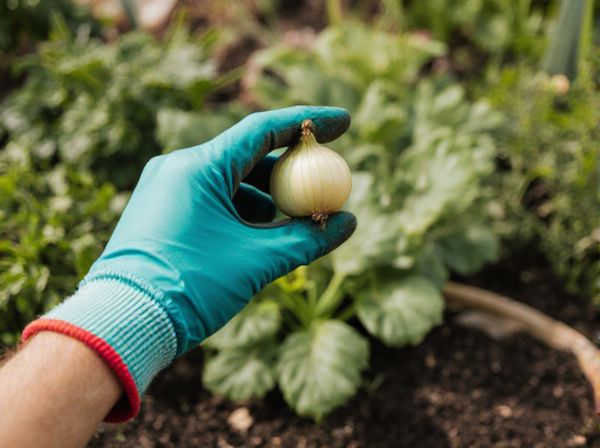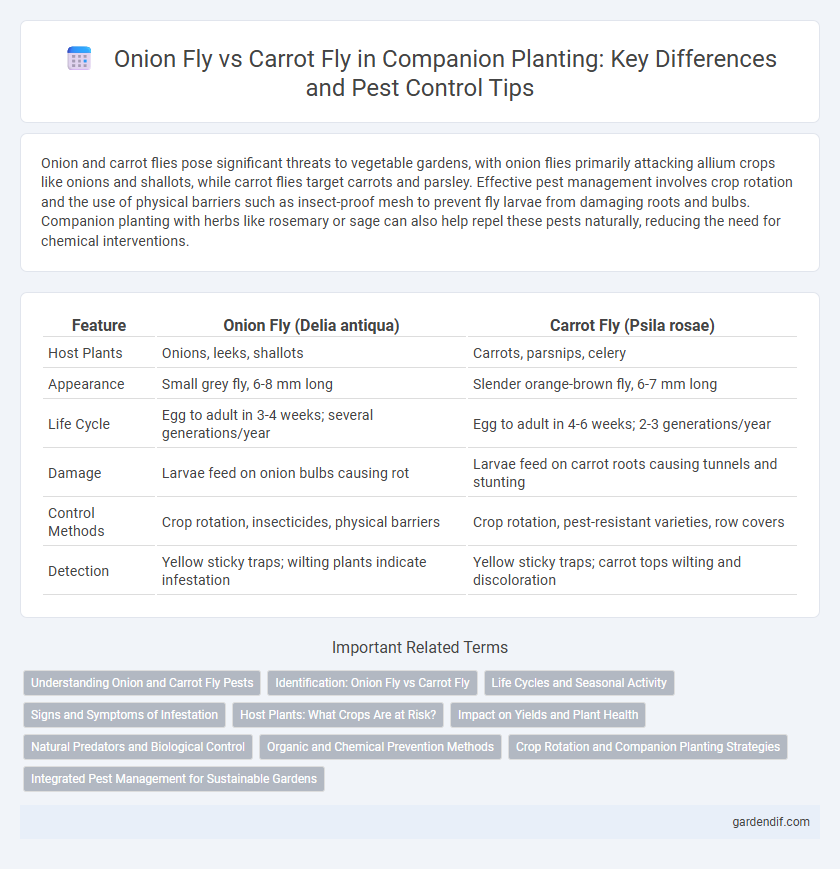
Onion vs carrot fly Illustration
Onion and carrot flies pose significant threats to vegetable gardens, with onion flies primarily attacking allium crops like onions and shallots, while carrot flies target carrots and parsley. Effective pest management involves crop rotation and the use of physical barriers such as insect-proof mesh to prevent fly larvae from damaging roots and bulbs. Companion planting with herbs like rosemary or sage can also help repel these pests naturally, reducing the need for chemical interventions.
Table of Comparison
| Feature | Onion Fly (Delia antiqua) | Carrot Fly (Psila rosae) |
|---|---|---|
| Host Plants | Onions, leeks, shallots | Carrots, parsnips, celery |
| Appearance | Small grey fly, 6-8 mm long | Slender orange-brown fly, 6-7 mm long |
| Life Cycle | Egg to adult in 3-4 weeks; several generations/year | Egg to adult in 4-6 weeks; 2-3 generations/year |
| Damage | Larvae feed on onion bulbs causing rot | Larvae feed on carrot roots causing tunnels and stunting |
| Control Methods | Crop rotation, insecticides, physical barriers | Crop rotation, pest-resistant varieties, row covers |
| Detection | Yellow sticky traps; wilting plants indicate infestation | Yellow sticky traps; carrot tops wilting and discoloration |
Understanding Onion and Carrot Fly Pests
Onion flies (Delia antiqua) and carrot flies (Chamaepsila rosae) are common pests affecting Allium and Apiaceae crops, causing significant damage to onions and carrots respectively. Onion flies lay eggs near the base of onion plants, where larvae tunnel into bulbs, while carrot flies target carrot roots, leading to stunted growth and rot. Effective pest management relies on monitoring adult fly populations and employing crop rotation to disrupt their life cycles.
Identification: Onion Fly vs Carrot Fly
The onion fly (Delia antiqua) is typically identified by its yellowish-gray body and dark stripes on the thorax, whereas the carrot fly (Chamaepsila rosae) has a more uniform grayish body with transparent wings. Onion fly larvae primarily target onions, leaving tunnels and decaying tissue, while carrot fly larvae burrow into carrot roots, causing orange-brown scarring and deformities. Recognizing these distinct physical and behavioral traits is crucial for effective pest management in vegetable gardens.
Life Cycles and Seasonal Activity
Onion flies (Delia antiqua) complete their life cycle in about 3-4 weeks, with eggs laid in soil near host plants and larvae feeding on onion bulbs during spring and early summer. Carrot flies (Psila rosae) have a similar life cycle length but target carrot roots, with peak adult activity occurring from late spring to early autumn, especially in warm, humid conditions. Both species produce multiple generations annually, with seasonal activity synchronized to the growth phases of their respective host crops, influencing pest management timing.
Signs and Symptoms of Infestation
Onion fly infestation is characterized by yellowing and wilting leaves, along with stunted growth and the presence of slimy tunnels in the bulbs, while carrot fly attacks cause dark, sunken lesions on carrot roots and a distinctive foul odor due to root decay. Both pests leave behind larvae that feed on plant tissues, leading to secondary infections and reduced crop yield. Early signs of infestation include wilting foliage and damaged underground parts, essential for timely pest management.
Host Plants: What Crops Are at Risk?
Onion fly (Delia antiqua) primarily targets Allium species such as onions, leeks, and shallots, causing significant damage to these crops by attacking the bulbs and roots. Carrot fly (Chamaepsila rosae) focuses on Apiaceae family plants, mainly carrots, parsnips, and celery, where its larvae tunnel into the roots, leading to decay and yield loss. Understanding these host plant preferences is crucial for implementing effective crop rotation and companion planting strategies to minimize pest infestations.
Impact on Yields and Plant Health
Onion fly larvae cause significant damage by burrowing into bulbs, leading to rot and yield loss, while carrot fly larvae attack roots, resulting in stunted growth and deformed crops. Both pests reduce plant health and marketable produce, but onion fly infestations typically cause more direct bulb destruction. Effective pest management is critical to minimize crop losses and maintain optimal yields in both onion and carrot cultivation.
Natural Predators and Biological Control
Onion and carrot flies are effectively managed through natural predators such as parasitic wasps like Trybliographa rapae and predatory beetles that target their larvae and pupae stages. Biological control methods include introducing beneficial nematodes that attack fly larvae in the soil, reducing their populations without harming crops. Crop rotation and intercropping with plants like chives or garlic further disrupt fly breeding cycles, enhancing natural pest control.
Organic and Chemical Prevention Methods
Onion and carrot flies are common pests that threaten allium and apiaceous crops, with organic prevention methods including crop rotation, companion planting using strong-smelling herbs like rosemary and sage, and the application of neem oil or insecticidal soaps to deter larvae. Chemical prevention often involves targeted insecticides such as synthetic pyrethroids and organophosphates, which must be used cautiously to avoid resistance development and environmental harm. Integrating organic barriers and chemical controls enhances pest management efficiency while supporting sustainable agricultural practices.
Crop Rotation and Companion Planting Strategies
Onion and carrot flies target crops in the Apiaceae family, making crop rotation essential to disrupt their life cycles and reduce infestation rates. Companion planting strategies involve interspersing onions and carrots with strong-scented herbs like rosemary or sage to mask host plant odors and deter flies. Integrating crop rotation with these companion plants enhances pest management by lowering pest populations and promoting healthier crop growth.
Integrated Pest Management for Sustainable Gardens
Onion and carrot flies pose significant threats to Allium and Daucus carota crops, requiring targeted Integrated Pest Management (IPM) strategies for sustainable garden health. Crop rotation, use of insect-proof mesh, and encouraging natural predators such as parasitic wasps effectively reduce pest populations without chemical reliance. Implementing IPM supports ecological balance, minimizes environmental impact, and promotes long-term crop yield stability in organic and conventional gardens.
Onion vs carrot fly Infographic

 gardendif.com
gardendif.com